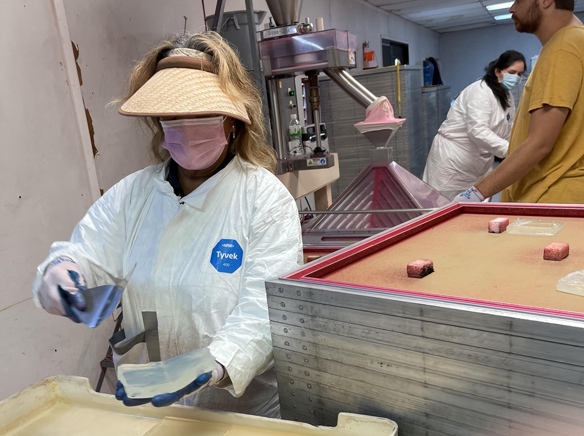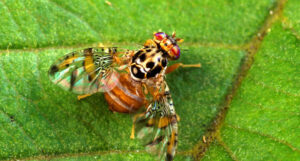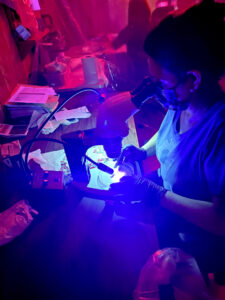
Quietly, yet efficiently, a small army of dedicated government employees wage war every day.
Operating from a proverbial Medfly Village, an enclave of metal buildings built in 1996 in a remote corner at the Joint Forces Training Base in Los Alamitos, the teams of state and federal workers are engaged in a battle with the wild Mediterranean Fruit Fly (Medfly), considered one of the world’s most dreaded pests.
Medfly program director Ian Walters, who has been with the program since its inception in the early 1990s, directs the attack like a general on a battlefield.
On the job, he walks briskly through the elongated rows of incubation units, refrigeration trailers, and testing chambers, checking with technicians, scanners, and processors along the way.
“The Medfly Preventative Release Program (MPRP)is a cooperative program of the California Department of Food and Agriculture (CDFA) and the U.S. Department of Agriculture (USDA),” said Walters during an extensive visit with ENE.
“The Medfly is one of the world’s most significant pests,” he said, “and that’s because it consumes about 250 different kinds of fruit, nut, berry, and vegetable crops, about 170 of which are grown in California and are protected by the program.”
In this role for more than three decades, Walters has become the de facto lord of the Medflies program, guiding a delicate environmental and logistical ballet that results in the targeted release of nearly 100 billion sterile male fruit flies over southern California each year.
Walters said the state has battled the Medfly since the 1970s, engulfing then-Gov. Jerry Brown in a showdown with the federal government over spraying the toxic pesticide Malathion to bring the infestation under control.

According to a New York Times Retro Report, the state declared victory against the Medfly in 1990, but two months later, more wild Medflies were found, prompting some to believe the pest had established a small, but firm foothold in the state.
Though some state officials deny it, James R. Carey, Distinguished Professor of Entomology at the University of California, Davis, said the Medfly is here to stay.
“The Medfly is really established throughout the state,” he told the Times. “There’s absolutely no question, but they’re very low populations and so what the state has done is really suppressed them, but they haven’t contained them,” said Carey.
“I do not agree with his assertion,” notes Walters, saying the breakthrough in the fight against the Medfly came with the development of SIT (Sterile Insect Technique), which of course, lies at the heart of the preventative release program.
Today, the release of millions of sterile male fruit flies lies at the heart of the state’s strategy to keep the Medfly at bay.
As the SIT technology emerged, state agriculture officials switched strategies, to an environmentally friendly pesticide. The program began with a test in 1992, he said, then built the Medfly Village on the base in 1994 and when the results were positive, announced the Preventative Release Program in 1996.
According to Walters, most flies have a life cycle of approximately 30 days. Yet, in that span, the male and female will mate, and the only way to stem the flow of wild Medflies into the environment is to have willing male Medflies ready to mate, yet sterile so there are no eggs.

Therefore, since flies have a 30-day life span, it takes an effort seven days a week, 24 hours a day and 365 days a week of strategically releasing sterile males into the environment to prevent outbreaks of wild and virile Medflies.
Walters said the Medfly is critical to control because it destroys the crops by injecting their eggs under the skin of fruits and vegetables and other crops. “The female will have her eggs fertilized and she will lay her eggs under the skin of the fruit,” said Walters.
“The female Medfly has an ovipositor, an appendage on the tip of the abdomen that will pierce the skin of the fruit. The female will lay the eggs under the skin of the fruit and those eggs will hatch and become larvae. The larva will consume the fruit,” he said.
With a $10 million annual budget, Walters said the program saves billions in losses.
“If Medflies were to become established in California, it would have a devastating impact,” said Walters. He said experts predict it would result in an estimated $2 billion in losses.
He said the losses would include direct losses from loss of crops, loss of export market, increased use of pesticides, and other cultural impacts.
Therefore, he said, “the program is charged with keeping the Medflies from gaining a foothold in the agriculturally rich SoCal and L.A. basin.”
The Los Al program serves an area of approximately 1,800 square miles within Los Angeles, Orange, Riverside, and San Bernardino counties.
The process of supplying 175 million sterile male Medflies each week is intricate and fascinating. The process from fly production to release over the skies of SoCal is intricate and always in motion.
How the Medflies are processed at Medfly village at JFTB is equally fascinating and how they are safely released into the skies owes its prowess to endurance and ingenuity.
Walters said the process starts at Medfly production facilities in Hawaii and Guatemala. It is truly a complex network that keeps the aerial Medfly preventative release program flying.
“We (CDFA) don’t keep a breeding colony of flies here in California. Because we don’t want to risk that any of those wild flies escape the facility and start an infestation,” said Walters.
Accordingly, all the current production is done offshore at one of these two facilities, he said. There are four stages in a fly’s life, said Walters, including egg, larvae, pupae, and emergence (adulthood).
Once the larvae reach the pupae stage, the last stage before adulthood, Walters said production workers “apply a marker dye to the pupae that will fluoresce under a UV light so we will be able to differentiate that sterile fly from a wild fly.”
The marker dye will only become critical to researchers when the Medflies complete their life cycle and end up in traps.
While still at the production facilities, after the dye is applied to the pupae, they are collected and put in special plastic bags and sent to USDA lab facilities for irradiation.
The bags are zapped with gamma rays and eventually loaded onto commercial cargo carriers that arrive daily from Guatemala and Hawaii. The radiation is measured so that the Medflies will eventually emerge from the pupae sterile, but the rays have no other impacts.
Walters said special couriers pick up the pupae and deliver them to the labs within the Medfly village at JFTB, where workers methodically process the incoming supply.
After a quality control check, the pupae are taken from the bags and put on special racks of layered trays, complete with two gelatin bars in each tray that will supply the incubating pupae with food and water.
Walters said the Guatemala Medflies are slightly smaller, so it takes 46 trays to house one million Medflies while the Hawaii Medflies take 56 trays to make a million fly “stack.”
The stacks are then taken to one of many “incubation chambers” in the village of container-size buildings. Walters points out small, computer-type compressor fans that are placed above each stack.
“This supplies air to the entire stack to keep the flies alive until they emerge,” he said.
It takes about four days for the flies to emerge from the pupae, he said, and on the third day, the sterile males get a bath of fly cologne, yes cologne of sorts, to make them more attractive to the waiting females.
After an overnight bath of ginger root oil, the Medflies are prepared for their trip into the wild. By giving the Medflies a scent of ginger root oil, scientists believe the sterile male Medflies will have a better than even chance of attracting a female, said Walters.
By releasing millions of sterile males into the population of wild flies, the population of wild flies that could fertilize the eggs is theoretically held at bay. For three decades, the program has worked and is beginning to attract worldwide attention.
The last stop for male Medflies is a trip to one of several refrigerated trucks located in Medfly Village, where technicians slowly induce a “chill coma” by lowering the temperature just to the point of inactivity.
By the time the flies are loaded onto the planes and are ultimately released, they will be awake and ready for their missions to mate.
A few hundred feet from the village sits an aging World War II-era hanger, which the program uses as a flight staging area.
“The aerial releases are conducted by Dynamic Aviation Group, Inc. (DAG) a private release operator under contract with USDA,” he said. The release program uses a fleet of four Beechcraft King Air, Model 90 turboprop planes.
Special devices and chutes have been retrofitted into the planes that hold the trays and can release the flies over the designated area. All planes fly with a crew of two, said Walters, to ensure proper release.
He said Medflies are released seven days a week, with at least three to four flights per day. A large map of the 1800-mile target area sits on the wall of Walters’ office that is divided into quadrants.
Flight controllers, such as Irma Zamora, Release Operations Supervisor, stay in constant touch with each flight to coordinate the Medfly release. In addition, the program uses “Flight Aware” to track each flight and is stored for backup if questions ever arise, said Walters.
Two months ago, when wild Medflies were found in Leimert Park in Los Angeles, the Los Al-based Medfly program was in the news again.
After two wild Medflies were found, authorities immediately set up a 69-square-mile quarantine area covering parts of Central L.A., Culver City, and South L.A.
Walters said the Medfly team scrambled to target the area to pepper the affected area with sterile males. “We were able to ramp up quickly and then drop 125,000 sterile males per mile to ensure there was no breakout,” he said.
Another small army collects samples from more than 100,000 traps across the area, said Walters, and couriers daily deliver those traps to Medfly Village for inspection.
“They have a microscope and a UV light,” said Walters. Looking at those traps are really cool,” he said.
“The marker dye will fluoresce on the sterols, but if they don’t detect the marker dye then they have a suspected wild fly,” he said, which raises alarm bells. The suspect fly is then sent out immediately for a secondary inspection.
Thus, the battle against the Medfly goes on, around the clock, every day of the year.
While government workers across oceans create billions of flies for release, another group is testing the traps every day to complete the cycle of protection against the dreaded fly.
“The program has proven to be a success, both in preventing and eradicating infestations when they do occur,” said Walters.
“I am proud of the work that has been done by the program and I personally derive great satisfaction in the fact that we have contributed to efforts to protect agriculture in California.”



